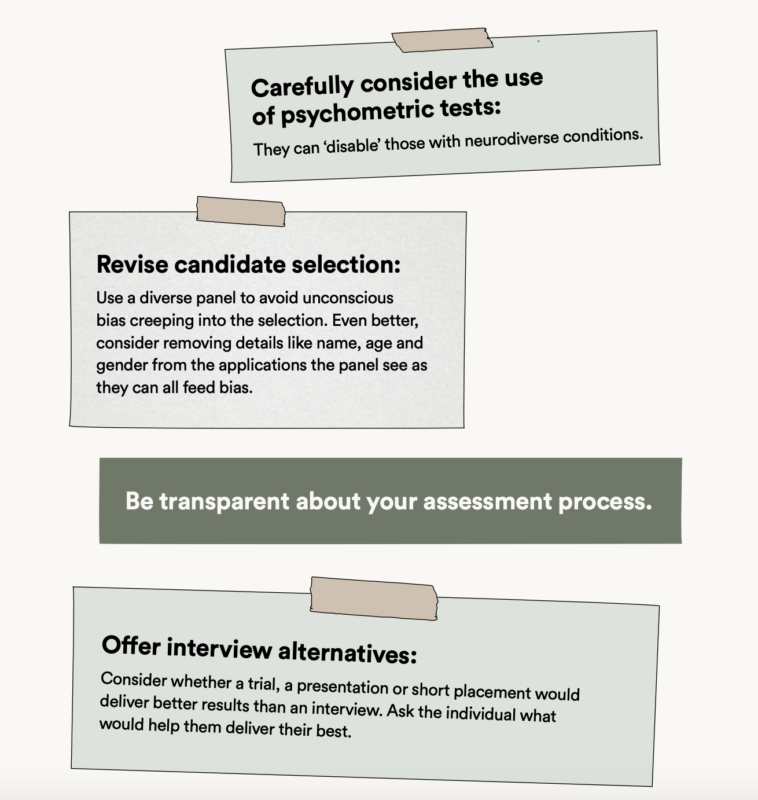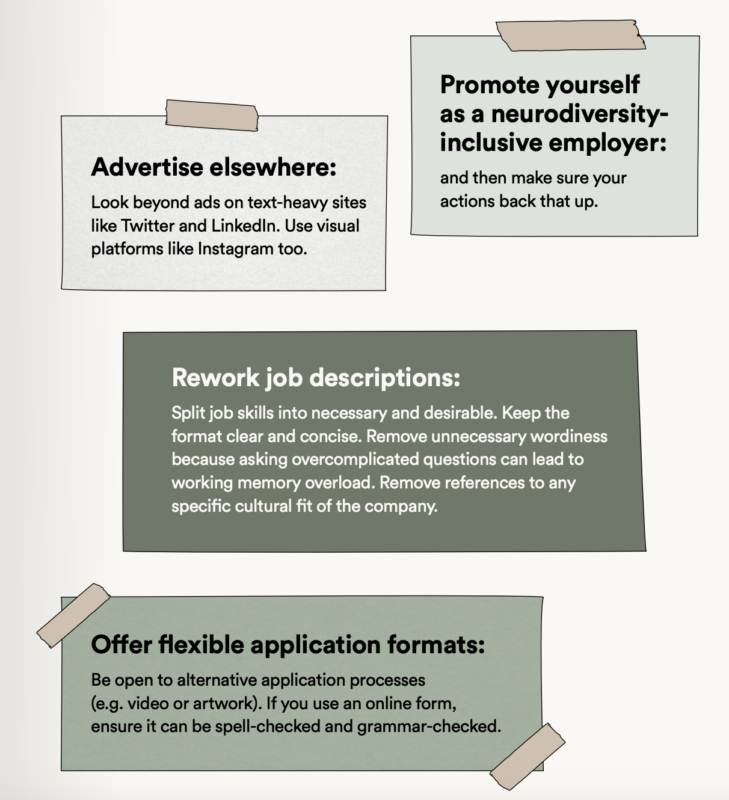Universal Music hit the nail on the head with its recent employer guide for supporting neurodiverse employees. Here’s how you can emulate its success.
If you haven’t already seen Universal Music’s recent neurodiversity handbook, Creative Differences, check it out… after reading this article of course. It gets so many things right.
It starts by normalising neurodiversity – that is, someone living with autism, dyslexia, ADHD and other conditions which include non-typical brain functioning – by including a foreword from Florence Welsh (Florence and the Machine). She’s someone who not only represents Universal’s industry but also acts as a role model for both neurotypical and neurodiverse people.
“It’s a really, really good guide,” says Andrew Eddy, co-founder of Untapped Group, the organisation behind the Neurodiversity Hub which supports neurodivergent people and aims to get them into the workforce.
The guide both informs neurotypical staff and shows neurodiverse staff that they’re welcome – and could be a prototype for organisations that want to do the same.
What should you include
“You’ve got to lead these things from the top,” says Eddy. “If an initiative starts to low down in an organisation there’s a real danger [that it won’t work].”
Importantly, this isn’t a handbook filled with cautionary tales that focuses on all the things neurodiverse staff can’t do. “The good thing about this guide is that it’s strengths-based. It’s about celebrating what neurodiverse people are exceptional at,” says Eddy.
The guide, which apparently took two years to create, follows a simple but effective formula:
- Begin by outlining what neurodiversity is and why it should be on an employer’s agenda. What might seem obvious to some will be new territory for others. It’s important to include information for all knowledge levels so conversations can be had across the whole business.
- A section on busting stereotypes. For example, a part of the guide is headlined, “We’re not all Rain Man”.
- A section that highlights the unique value neurodiverse staff can bring.
- Backing up your claims with evidence. Universal conducted research that helps put the guide into context. For example, 75 per cent of the organisations surveyed didn’t have any policies in place to support neurodiverse staff. While you don’t have to go into this much detail, you could consider conducting interviews with staff to get a full picture of where your company is starting from.
- A comprehensive list of recommendations. This is likely the most valuable part of the whole guide, and can include advice around recruitment, onboarding, career progression, mentorship and much more.
- Information about how the guide was put together (with an emphasis on neurodiverse involvement).
- A glossary that provides more detail around neurodiverse conditions.
“They’ve done the recommendations part of the guide really well, in terms of putting simple messages in and walking through it step by step, and backing it up with anecdotes from people with lived experience,” says Eddy.
It’s also a good idea to include information that managers might not have considered before, such as addressing employee’s emotional needs. For example, the Universal guide reads:
“Establish a confidential record of conditions, prior triggers, needs or requirements that can be shared at the discretion of the individual. Offer and direct individuals to external job coaches or other forms of support. If an employee wishes to disclose their condition to their team, give them support and encouragement to produce a bio of their working style. The bio should explain how their ND characteristic may affect work and behaviour, for instance a person with ADHD may explain they need time to recover after an intense period of working.”

Eddy commends the fact that the guide includes neurodiverse voices throughout. People with lived experience need to be consulted, if not commissioned to create these policies.

The small things really matter
While those charged with creating a guide like this might have great ideas for its content, the way it’s put together really matters too.
For example, someone with low vision or colour vision deficiency might have had trouble reading the last sentence, as greens, pinks and reds are more difficult for some people to read.
Design principles like this are what Universal Music would have had front of mind when developing their handbook. It hired London-based artist Megan Rhiannon, who lives with autism and aphantasia, to design this handbook. This was a great decision as Rhiannon is her own audience.
Each colour was carefully chosen – notice the cream coloured background paired with darker text – and contrast levels are optimised throughout. It’s full of simple illustrations (nothing too distracting) and bite-sized pieces of information.
While these specific design tips aren’t mentioned in Universal’s guide – it focuses on bigger picture stuff – it’s likely that with Rhiannon on board, other aesthetic elements would have been taking into account, such as formatting specifics.
Fonts such as Arial, Comic Sans, Tahoma and Verdana are often easier to read; they’ve been described as “less crowded” than other fonts. Serif font, on the other hand, tends to make reading much more difficult as it has ‘hooks’ at the end of each letter. Bolding text is often helpful for emphasis but italics and underlining words can also make words appear crowded.
It’s best practice to be straightforward with language; use active rather than passive language and utilize tools like bullet points, infographics and glossaries clarifying jargon/abbreviations (this is a good idea for neurotypical staff too; jargon is just the worst).
Of course, everyone will have their own preferences for colour, contrast levels, fonts, and so on – there’s no one size fits all approach. It’s a good idea to ask neurodiverse employees how they prefer to consume their information and do what you can to facilitate their (often very simple) requests.
Small touches make the world of difference for a neurodiverse person reading your guide and will help turn a well-intentioned document that might miss the mark into something that’s truly inclusive.
Complementary actions
An organisational document like this is only the first step. Eddy offers a few tips for organisations that want to be more inclusive with neurodiverse staff.
- Consider partnering with third parties that can train neurotypical staff on how to support neurodivergence in their workforce. Eddy partners with an e-learning platform that offers a bite-sized ‘neurodiversity 101’ course. It’s a good idea to walk your talk and pair a neurodiversity guide with on the ground training.
- It’s not enough to be educated, you have to be strategic. For example, you have to think in advance about the workload of autistic employees, as Eddy says they cannot create extra work for themselves. “Some people can fake it, autistic staff can’t. If they run out of work they can get anxious.”
- Identify the managers or co-workers who are going to make the employment relationship work. But remember that “you’ve got to train all co-workers to be accepting and supportive. This is why programs failed 20 years ago, because they just plonked people in.”
- Make sure to have ongoing conversations with neurodiverse employees. “It’s not as simple as just sitting down and asking them what they want. Some of them might not have worked before. It’s a process.”
- Consider the environment. As HRM previously covered in our feature on autism in the workplace, hot-desking, fluorescent lights and noisy spaces can be distressing for some staff, so think about how you can accommodate this.
What measures does your company take to support and encourage neurodivergence in your organisation? Let us know in the comment section below.


[…] gaudy use of rainbow font (he probably didn’t know comic sans is sometimes preferred by some neurodiverse employees), I asked if he completed the pulse survey. He unequivocally told me he had not, and […]
I am currently study my Cert 4 in Human Resources and found this so interesting. Thank you
[…] This neurodiversity handbook should be a prototype for all workplaces […]